Side cap
A side cap is a military cap that can be folded flat when not being worn. It is also known as a garrison cap or flight cap in the United States, wedge cap in Canada, or field service cap in the United Kingdom.[1] In form the side cap is comparable to the glengarry, a folding version of the Scottish military bonnet. It has been associated with various military forces since the middle of the 19th century, as well as various civilian organizations.

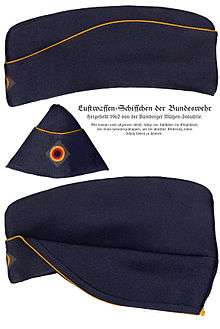
Australia
All ranks of the Royal Australian Air Force (RAAF) are entitled to wear the blue garrison cap with appropriate cap badge in service dress and flying dress uniforms.[2] The piping of the garrison cap for air officers is light blue, the piping for all other ranks is solid blue.[3]
The RAAF is the only branch of the Australian Defence Force entitled to wear garrison caps.
Canada
Army
In the Canadian Armed Forces, the field service cap (French: calot de campagne) is defined by the Canadian Forces Dress Instructions as a "cloth folding or 'wedge cap'...Originally designed for wear during field operations and training, it may now also be worn as an undress cap with full and undress uniforms."[4] The cap is worn as part of the undress uniform by students of Royal Military College of Canada,[5] and as an optional item by all ranks of rifle regiments with ceremonial dress, mess dress, and service dress uniforms.[6]
The field service cap was originally adopted army-wide in 1939, and replaced in 1943 by a khaki beret. The coloured field service cap was a variant permitted for private purchase and worn only when off duty. These were in the colours of the regiment or corps of the wearer.
Air Force
For personnel who wear air force uniform, the blue wedge cap (French: calot) is authorized for wear with all orders of dress, save for the combat uniform.[7] It is properly worn "on the right side of the head, centred front and back, with the front edge of the cap 2.5 centimetres (1 in) above the right eyebrow."[8] Cap badges are worn on the left side, with the centre of the badge 6.5 centimetres (2 1⁄2 in) from the front of the cap centred between the flap and the top seam.[9] The cap worn by general officers is embellished with silver piping.[10] Air force military police in dress uniform wear a scarlet flash in the front of their wedge caps showing 1 centimetre (3⁄8 in). Air force members of Canadian Special Operations Forces Command wear a tan flash in the front of their wedge caps.[11]
Prior to Unification in 1968, the Royal Canadian Air Force wore uniforms similar to those worn by the Royal Air Force, including a blue wedge cap. After 1968, the uniforms of the three services were replaced by a universal rifle-green uniform; the air force, however, was permitted to retain the wedge cap, although in rifle green instead of blue. With the advent of the Distinct Environmental Uniform, the blue wedge cap returned.
The wedge cap is also the official headdress of the Royal Canadian Air Force Association and the Royal Canadian Air Cadets.
Italy
In the Italian language, the side cap is called bustina. It was adopted by the Royal Italian Army in the 1920s, and by the 1930s it was the main cap used by personnel belonging to the Royal Italian Army, the Regia Aeronautica (air force) and the Blackshirts. It remained in use until well after World War II.
France
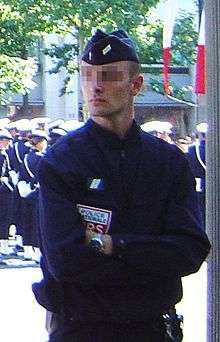
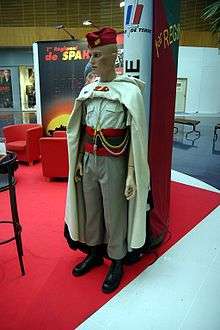
The French bonnet de police (or "calot") had originated as a long, pointed headdress, with a tassel at the end of the trailing crown (or 'flamme').[12] Gradually the flamme grew shorter until by the mid-nineteenth century the bonnet de police had become a true folding cap with no trailing crown. Instead the tassel dangled from a short cord sewn onto front point of the crown, hanging above the soldier's right eye.[13] This style of headdress with a hanging tassel was widely worn by both the Belgian Army[14] and the Spanish Army during the first half of the 20th Century. It is still used by the Spanish Foreign Legion.[15]
When reintroduced for undress or fatigue wear in 1891[16] the French army's bonnet de police had become a plain item of dress without decoration. The colour of this working cap matched that of the tunic with which it was worn (either dark blue, light blue or black prior to World War I;[17] horizon blue from 1915 to 1930; and thereafter khaki).[18] In 1915 the "bonnet de police" generally replaced the kepi for other ranks during the remainder of the First World War, because of its greater convenience when the "Adrian" steel helmet was issued.[19]
Between 1944 and 1962 however this headdress was worn by most branches of the French Army in a wide variety of colours, which normally matched those of the kepis historically worn by the particular branch or regiment. Line infantry caps for example had a dark blue base with a red top.[20] In 1959 the bonnet de police was replaced by the beret for most units.[21]
In the modern French Army the bonnet de police is worn by the 1st Regiment of Spahis in the historic bright red of this branch and, since 2017, by the 1st Tirailleurs in light blue.[22] The bonnet de police is also worn by anti-riot law enforcement units, such as the Gendarmerie Mobile of the French Gendarmerie (at least when in riot control gear) and the CRS of the French National Police. Members of these units may have to change quickly from an ordinary headdress to a helmet, and an easily foldable cap is therefore practical.
Norway
In Norway, this is known as båtlue, literally boat cap and is used by the Royal Norwegian Air Force. The Royal Guards use a distinct variety commonly known as gardelue which is worn in garrison and while on leave.
Portugal
.jpg)
In Portuguese service, the side cap is known as barrete de bivaque (bivouac cap) and often referred simply as bivaque.
Two basic models are in use by the armed forces, the security forces and the fire services of Portugal.
The first model has a curved top line and is used by the Portuguese Air Force (all personnel, except members of Air Police), the Portuguese Navy (officers and sergeants), the Public Security Police (all personnel, except members of special units) and the fire services.
The second model is a pointed cap and is used by the Portuguese Army (only personnel in training) and by the National Republican Guard (GNR).
Russia/Soviet Union


In the Soviet Union, the garrison cap was known as pilotka (пилотка, from "pilot" — the original cap was a part of the air force pilots' uniform in World War I). It was the most common type of cap used by the Red Army during WWII and after until the 1980s. The pilotka was worn during the summer season instead of the winter ushanka. It continues to be worn in modern Russia, although more in the Air Force and the Navy, especially among submarine personnel, where its compactness is inherently practical. In the Ground Forces the pilotka has been more or less displaced by the patrol cap and the beret as an undress headgear, although it remains in the regulations. Navy tropical uniform also features the peculiar vizored pilotka, to protect its wearers from the sun. The garrison cap was also the standard dress headgear for women in all of the Russian armed services (except for those units authorised to wear berets, such as airborne troops and marines), until replaced in March 2017 by the world-standard female peaked cap.
Aeroflot flight attendants wear a scarlet-colored garrison cap with a gold Aeroflot winged sickle-and-hammer stitched in the center.
Spain
The gorro de cuartel – referred to variously as gorrillo, gorra, chapiri or platano – was modelled on the later versions of the French bonnet de police and has the same vestigial tassel hanging from the front of the crown. The gorro de cuartel was originally known as the Isabellina; a large beret-like headdress which also included a tassel and was worn by the supporters of Queen Isabella II during the Carlist Wars of the mid-19th century.
It was in common use by both sides during the Spanish Civil War and continued in use by the Francoist forces after the war ended. It is now the distinguishing headgear of the Spanish Legion who wear it in barracks and on parade.
Sweden
In Sweden this style of headdress is known as a "båtmössa" (lit. "boat cap"). It is mainly used by the Swedish Police Authority, and also by Navy and Air Force personnel.
United Kingdom
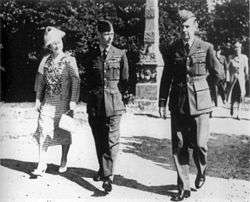
In the British Army, the first cap to be adopted of this style was the "Glengarry", which was authorised for all British infantry regiments in 1868 (although Scottish regiments had been wearing a round version since 1848 called a Kilmarnock[23] or Humle bonnet, which had been folded to make a side cap). The Glengarry was replaced for officers of most non-Scottish units by a cap called the "Torin" (similar in shape to the USSR's pilotka), which was worn from circa 1884 until 1896, when it too was replaced by a style for all ranks known as the "Austrian Cap", which had a fold down arrangement, giving the appearance when unfolded of a balaclava, thus warming the ears and back of the neck. The Austrian Cap (officially known as the Field Service Cap) was then replaced by an entirely different style of head dress in 1902 and so went into abeyance from general usage, although officers continued to wear them as a private purchase item of undress uniform. An all-khaki version was also selected in 1912 as a practical head dress by the fledgling Royal Flying Corps that went on to become the Royal Air Force (who continue to use the same type of cap to this day).
In 1937, a khaki field service cap, described in an amendment to the Dress Regulations for the Army that year as "similar in shape to the Glengarry" was introduced as the Universal Pattern Field Service Cap, and saw extensive service during World War II as a head dress to be worn with Battle Dress when steel helmets were not required. At around the same time coloured versions were introduced for officers of both regular and territorial regiments, although these were an optional item and in the midst of war not every officer chose to purchase one. Nevertheless, some did and they were produced in a wide range of colours for the different infantry, cavalry and yeomanry regiments.
Since the universal introduction of the beret in 1947, the field service cap continued as an optional officer's accessory to be worn in barrack dress (as an alternative to the peaked, khaki Service Dress cap). They are still tailored in regimental colours and have become less common with the introduction of Combat Soldier '95 camouflaged uniform (which for the first time serves as both barrack and combat dress), although they are still worn by the Rifles, Royal Artillery and some cavalry and other infantry regiments. A more obscure type known as the "Tent Cap" is worn by officers of the Queen's Royal Hussars only and is unique in that it is not fitted with a badge, but identified instead by its regimental colouring. Its origins lie with one of their forebears, the 8th Kings Royal Irish Hussars, who adopted the cap in WW2 to reflect their long association with the Danish Royal family, whose Life Guards wear a similar design of cap with their undress uniform. This cap is in turn based on the French, 'bonnet-de-police', that was worn by Hussars in the Napoleonic wars and after. The Torin style of cap is still worn by the Duke of Lancaster's Regiment and the Royal Dragoon Guards.
In the Royal Air Force, a blue-grey field forage cap[24] (sometimes called the 'chip bag hat') of an identical style remains widely worn with both working dress and flying suits.
United States
In the U.S. Armed Forces it is known as a garrison cap, campaign cap (not to be confused with campaign hat, a distinct form of headgear), flight cap, garrison hat, fore-and-aft cap, envelope cap, or overseas cap.
U.S. Army
When first issued to U.S. "doughboys" in World War I, the hat was called the overseas cap as it was only worn by troops in France who were given the French type forage cap, as they did not have their wide-brimmed campaign hats with them. The overseas cap could be stored easily when the helmet was being worn. A blue overseas cap was adopted post-war by the American Legion, but the hat largely disappeared from the Army between the wars, with the exception of the Army Air Corps (who called it the "flight cap") where it was authorized in August 1933[25] and armored units. However it returned in 1939 with a finalized specification as of February 1941. The hat was widely issued from then on as "the garrison cap." With the replacement of the service cap and campaign hat, the garrison cap was given branch of service color piping, as had earlier been the case with the cord of the campaign hat (light blue for infantry, red for artillery, yellow for cavalry, etc.). This practice was discontinued when individuals had to purchase a new hat if they were transferred to a different branch of the service. Officers' piping was similarly carried over from campaign hat cords and continues: warrant officers' caps are piped in silver and black, commissioned officers' caps are piped in gold and black, and general officers' caps are piped in gold.
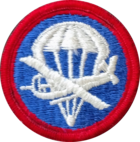
Additionally, starting in World War II military parachutists and glider-born forces wore an Airborne Insignia on their garrison cap—enlisted wore them on the left while officers wore them on the right.[26][27] Different variants of the Airborne Insignia were worn until later in World War II when different parachute and glider formations combined their unit specific insignia into one red, white, and blue, parachute and glider Airborne Insignia.[28] The Airborne Insignia continued to be authorized for wear on the garrison cap by those assigned to airborne units until the garrison cap was replaced with the Army's black beret.[27][29][30]
Until May 2004, it was also part of the initial uniform issue for soldiers who received their Army Green Service Uniform before becoming MOS-qualified, and thus being allowed to wear the standard black beret. The green service uniform was removed from use in October 2015.[31]
With the U.S. Army's introduction of a new service uniform based on the WWII-era "pinks and greens" officers' service uniform for 2020, a garrison cap will be included.[32]
U.S. Marine Corps
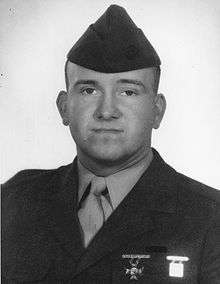
The overseas cap ("cover") was first issued to Marines in France in early 1918. Originally Marine officers wore red piping and Marine generals wore gold piping with all ranks wearing the Eagle, Globe and Anchor on the left hand side.[33] The cover was made in both forest green wool and khaki cotton.
Usage is common in the U.S. Marine Corps as the headgear when wearing service uniforms (the other option being the bulkier frame-type "barracks cover"). In addition, it is the standard headgear for Marine Naval Aviators, Naval Flight Officers and enlisted Aircrewmen wearing flight suits. The Marine officer's garrison cap, unlike those of the Army or Air Force, does not have metallic piping; the only marking that distinguishes it from the enlisted cap is the placement of small officer's rank insignia on the right side of the cap and the style of the Eagle, Globe and Anchor. Enlisted garrison caps carry no rank insignia, however all Marine garrison caps carry the Eagle, Globe, and Anchor insignia on the left side.
U.S. Air Force
A blue flight cap is the most common headgear worn with the U.S. Air Force's service dress or "blues" uniform. The color of the piping varies: solid blue for enlisted, blue and silver metallic braid for company-grade officers and field grade officers, and solid silver metallic for general officers. Officers wear large metal rank insignia affixed to the left front of the cap in a manner similar to that historically used by the Army with their garrison caps. No other accoutrements are worn.[34] The flight cap is also worn by members of the Civil Air Patrol in a manner appropriate to their rank. The company-grade officer version is also worn by United States Air Force Academy and Air Force ROTC cadets as well as officer trainees at officer training school. Cadets in the Junior ROTC and Civil Air Patrol cadet programs wear the enlisted version of the flight cap.
U.S. Navy
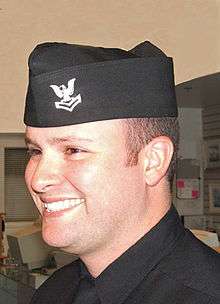
In the U.S. Navy the garrison cap ("cover") was first authorized during World War II, originally for aviators and later for all officers and chief petty officers (CPOs). Blue and white versions, as well as a forest green version for aviation officers and CPOs were later developed, although the blue and white versions were discontinued after the war. Today, garrison caps in khaki are almost always worn with service khakis and flight suits. Officers wear a miniature version of the officer crest on the left and small rank insignia on the right side of the cap, while CPOs will wear a CPO, SCPO or MCPO fouled anchor on the left as appropriate. Like the Marine Corps, and in contrast to their Army and Air Force counterparts, the Navy caps for officers also avoid the use of metallic piping. The blue version garrison cap, essentially black, was resurrected in the mid-1990s for wear with the blue working uniforms. Enlisted personnel since 2008 have been issued a black garrison cap for wear with the new Navy Service Uniform. It has since been authorized for the officer and CPO Service Dress Blue uniforms. The garrison cap is also worn by midshipmen and officer candidates.
U.S. Coast Guard
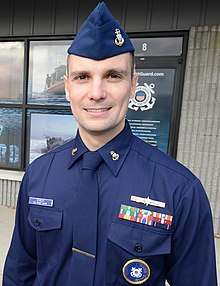
The U.S. Coast Guard issues the garrison cap ("cover") to all service members. The cap is serge and is authorized with Tropical Blue, the Winter Dress Blue, and Service Dress Blue uniform. Regulations for the placement of insignia are similar those of the U.S. Navy and Marine Corps. Unlike the Navy, enlisted members in the rates E-1 through E-3 wear a miniature version of the enlisted combination cap device. Like the Navy and Marine Corps, and in contrast to their Army and Air Force counterparts, the Coast Guard garrison caps for officers also avoid the use of metallic piping.
Serbia/Yugoslavia

In Serbia, the side cap is known as "Šajkača" and was introduced to Serbian soldiers in 1870. It was an integral part of the uniform of Serbian soldiers in the Serbo-Turkish War (1876-78), the Serbo-Bulgarian War (1885) and the Liberation Wars (1912-1918). It was used as the official cap of soldiers in the Yugoslav Army and Gendarmerie in the Kingdom of Yugoslavia. During the German-Italian occupation of Yugoslavia in the Second World War it was worn by numerous armed formations. After the war in the new Yugoslavia, the official cap was replaced by a "Titovka" which was of the same style as the side cap. "Titovka" was first used by the Yugoslav Partisans during WWII and later by the Yugoslav People's Army. The Titovka was named after Josip Broz Tito, leader of the partisans, who popularized its use during the war.
Civil use

Officers and Instructors of the Australian Air Force Cadets are also entitled to wear a garrison cap with service dress uniform.[35]
Royal Canadian Air Cadets wear wedge caps in Air Force blue as part of their uniform.
United States Civil Air Patrol personnel wear the US Air Force Flight Cap with distinctive CAP hat insignia. Senior members (ages 18 and above) will wear the company grade/field grade officer or general officer style flight cap, dependent on CAP rank, but will wear a small version of the service hat device in lieu of rank insignia in order to distinguish themselves from actual Air Force officers (e.g., those in the active duty regular Air Force, the Air Force Reserve and the Air National Guard). CAP Cadet officers will wear the Air Force enlisted flight cap with cadet rank insignia instead of the CAP insignia, while cadets who are not cadet officers will wear a generic insignia. This hat is the standard cover with most of the Air Force style uniforms.[36]
Many uniformed civilian organizations such as the Boy Scouts of America (which no longer uses them) have used garrison caps.
Waiters at many old fashioned style diners also wear garrison caps.
The American Legion and many other veterans service organizations wear distinctive garrison caps.
Some commercial air-line employees, particularly flight attendants, wear garrison caps.
Participants of U.S. military ROTC and JROTC programs are issued garrison caps for the duration of their studies.
The Massachusetts Maritime Academy and State University of New York Maritime College[37] also require their cadets to wear garrison covers.
New York City Police Department trainees in the Corps of Cadets and the Police Academy also wear garrison covers.
Members of the Union Drum Corps wear Garrison Caps during their performances.
The boys brigade have Garrison Caps as part of their uniform as well.
See also
References
- Dress Regulations for the Officers of the Army 1900. The War Office. 1900. ISBN 0-85368-044-2.
- "Chapter 2". DI(AF) AAP 5135.003 (AM1) – Manual of Dress. Royal Australian Air Force. 15 September 2008.
- "Chapter 5". DI(AF) AAP 5135.003 (AM1) – Manual of Dress. Royal Australian Air Force. 15 September 2008.
- Canadian Forces Dress Instructions, chap. 1, ¶ 22
- Canadian Forces Dress Instructions, chap. 5, Annex B, ¶ 2
- Canadian Forces Dress Instructions, chap. 6, sect. 1, ¶ 4c
- Canadian Forces Dress Instructions, chap. 6, sect. 1, ¶ 5
- Canadian Forces Dress Instructions, chap. 2, sect. 2, ¶ 15d
- Canadian Forces Dress Instructions, Annex D, Appendix 1
- Canadian Forces Dress Instructions, chap. 3, sect. 2, ¶ 9
- Canadian Forces Dress Instructions, chap. 6, sect. 1, ¶ 5c
- Crody, Terry (3 April 2009). French Revolutionary Infantryman 1791-1802. p. 60. ISBN 978-2-35250-105-3.
- Jouineau, Andre. L'Armee de Napoleon III dans la Guerre de 1870. pp. 15–16. ISBN 978-2-84048-511-7.
- Liliane et Fred Funcken, page 107 "L'Uniforme et les Armes des Soldate de las Guerre 1939-1945" vol. 1, Casterman 1972
- Bueno, Jose. Uniformes Contemporaneos del Ejercito Espanol. pp. 72–74. ISBN 84-7140-186-X.
- Mirouze, Laurent (2007). The French Army in the First World War - to battle 1914. p. 54. ISBN 978-3-902526-09-0.
- Coune, Frederic (25 June 2012). Les Coiffures Militaires Francaises 1870-2000. p. 16. ISBN 978-2--35250-241-8.
- Francois Vauvillier, page 21, "Uniformes 1940 L'Infanterie", Argout-Editions Paris 1980
- Jouineau, Andre (3 April 2009). French Army 1918. p. 17. ISBN 978-2-35250-105-3.
- Gaujac, Paul (2012). Officiers et Soldats de L'Armee Francaise 1943-1956. pp. 19–32. ISBN 978-2-35250-195-4.
- Coune, Frederic (25 June 2012). Les Coiffures Militaires Francaises 1870-2000. p. 74. ISBN 978-2-35250-241-8.
- Dufour, Pierre (3 April 2009). 1er Régiment de Tirailleurs. pp. 152 & 155. ISBN 978-2-35250-105-3.
- Major R. M. Barnes, page 284 "The Uniforms and History of the Scottish Regiments, Sphere Books Ltd, London 1972
- http://www.raf.mod.uk/rafcms/mediafiles/0F179C00_5056_A318_A8D8F975CD47447B.pdf
- Rottman, Gordon US Army Air Force (2) Osprey Publishing, 18 Sep 2012
- The 505th Parachute Infantry Regiment, Unit History and Group Photograph of the 505th PIR, circa 1942, ww2-airborne.us, last accessed 3 July 2018
- Army Regulation 670-1, Wear and Appearance of Army Uniforms and Insignia Headquarters Department of the Army, dated 22 May 2000, last accessed 3 July 2018
- Other Insignia not Shoulder Sleeve Insignia, Garrison Cap Insignia of Airborne Units, Second World War, Angelfire.com, by Dr. Howard G. Lanham, dated 2001, last accessed 4 July 2019
- Army Regulation 670-1, Wear and Appearance of Army Uniforms and Insignia Headquarters Department of the Army, dated 1 July 2002, last accessed 3 July 2018

- History of the Army Beret, CSA SENDS - THE ARMY BLACK BERET, armyreal.com, last accessed 2 July 2017
- "ALARACT 099/2011: UPDATE ALARACT MESSAGE 202/2008 ARMY SERVICE UNIFORM (ASU)" (PDF). Joint Base Elmendorf-Richardson Website. U.S. ARMY. Retrieved 11 February 2015.
- Army Green uniform will include garrison cap, three optional jackets, Stars and Stripes, by Corey Kickstein, dated 19 November 2018, last accessed 4 July 2019
- p.13 Henry, Mark US Marine Corps in World War I 1917-18 Osprey Publishing, 23/10/2012
- "Archived copy" (PDF). Archived from the original (PDF) on 2007-10-26. Retrieved 2007-09-02.CS1 maint: archived copy as title (link), Air Force Instruction 36-2903.
- Australian Air Force Cadets Manual of Dress. Australian Air Force Cadets. 13 December 2013.
- CAPM 39-1, downloaded 10 Sept 2010 from http://www.capmembers.com/media/cms/u_082203102943.pdf
- Maritime College, State University of New York, Uniform Regulations For the Regiment of Cadets, downloaded 5 Sept 2015 from http://www.sunymaritime.edu/sites/default/files/media/Documents/SUNY%20MARITIME%20UNIFORM%20REGULATIONS%20%28final%20%2009FEB15%29.docx
External links
| Wikimedia Commons has media related to Side caps. |